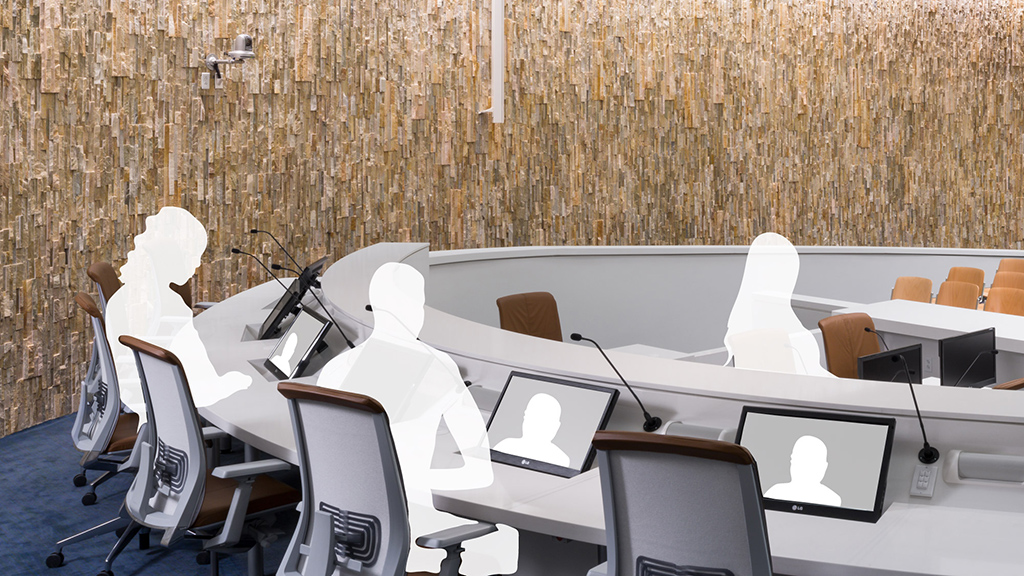How the Pandemic Can Lead to Better Public Meetings
April 10, 2020 | By Robert A. Peck and Sumita Arora
Editor’s Note: This post is part of our ongoing exploration of how design is responding to the COVID-19 pandemic.
Public meetings are the foundation of modern participatory democracy. Many government actions cannot happen unless and until citizens have a chance to express their views to officials in person. So, what do we do when it’s dangerous or impossible to gather people in public places? How should governments respond now and in the future?
Whether it’s because of the current pandemic and mandates for social distancing or natural disasters that make transportation dangerous or impossible, governments have an opportunity to conduct public meetings virtually. To do that, they need to rethink and redesign their civic meeting rooms to make public meetings accessible to more of the citizenry. A combination of technology and design can show the way.
In recent weeks, many businesses and organizations have remained productive by tapping into interactive technology. By contrast, public business is often just being postponed. Planning and zoning hearings and legislative committee hearings require more people in a room than the CDC guidelines recommend. As a result, important actions that we will want to resume as soon as it’s safe to do so (things like transportation projects, new housing starts, and school curriculum changes) will be delayed, because the required public comment processes and approvals can’t occur.
As many are learning during the COVID-19 crisis, interactive technologies already exist that can connect dozens or hundreds of people at a time by video feeds. Why couldn’t we apply these same learnings to city, state, and municipal meeting spaces so that they can function virtually? It would allow current public meetings to continue, but it could also usher in increased participation in local government once we get through this health crisis.
Not all states allow videoconference meetings, but that’s changing. Some states, like California, Virginia, and Texas, already have laws on the books that allow for digital meetings. Others, like Massachusetts, only recently opened the door to remote participation as a response to COVID-19.
It also takes a specific skill set to design for and produce virtual meetings. Many public bodies that currently broadcast their proceedings have simply placed cameras as best they can in council chambers or hearing rooms that were not originally designed for video production.
Many meeting rooms have cameras that can pivot to catch shots of all the members of the deciding panel, and most also have one shot of the person who is testifying. But few public bodies, if any, have designed their public assemblies from the outset to capture the best angles or to optimize audio, especially from public witnesses.
By taking a page from the design of broadcast studios, government buildings can become more digitally savvy relatively quickly. For example, rather than placing a witness table or lectern directly in front of a raised podium for officials, the witness table could be at a 120-degree angle from the panel, allowing for better camera angles of everyone and a more dynamic interchange. (Think, for instance, of the way talk show hosts are positioned in relation to their guests.)
In addition, grid-mounted ceiling lights and boom mics could create better, more vivid images and improved sound quality for those watching at home. A green screen behind the panel and witness table would allow different logos and graphics to be quickly and easily projected.
Large video screens in the meeting room could allow witnesses and members of the general public to present their comments remotely from wherever they have an internet connection. Members of the governing bodies could also appear on screen if they are unable to attend a session in person.
Adopting these new design and technology models for public hearing rooms would be a step forward – and not just in times of crisis. In ordinary times, they would allow a part-time commissioner or board member who can’t attend to participate in a critical hearing. For citizens who may not be able to travel to a distant hearing room, or who don’t have hours to spend waiting for a chance to speak, they could monitor a hearing from work or home and speak when it is their turn — or submit an online comment anytime! And, in general, this approach would give the public broader access to government. Who could argue against that?
For media inquiries, email .


